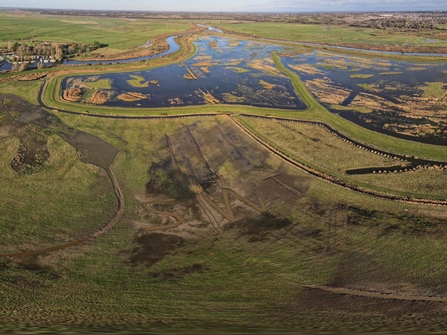Weekly wild news from our reserves - 27 November
Frost at Church Farm - Jamie Smith
National Tree Week runs from 28 November to 6 December. It is the UK’s largest annual tree celebration, marking the start of the winter tree planting season. Giles Cawston, our Woodlands Warden, has been working at Bradfield Woods and Combs Wood over the past fortnight where he came across two breath-taking individual specimens planted many years ago and now well worth celebrating. ‘I'd been slowly coppicing my way through this compartment when I noticed this looming behemoth of a tree. Such an exciting part of my job, never knowing what you might come across. Judging by its size, it must be a 150-year-old oak coppice stool. I've never seen anything like it in a woodland before. Usually, oaks would be left as singular, straight trunked trees to grow on for high quality products. We’ve earmarked this oak as a character tree within the wood.’
Oak coppice at Combs Wood - Giles Cawston
‘The crab apple at Bradfield’ continued Giles, 'was used by the UK’s late leading historian and ecologist of British woodlands, Oliver Rackham, when he visited the woods to give walks. He reckoned it is the oldest crab apple in East Anglia. I love it because it is the first tree in spring to blossom, attracting early spring flying insects to its energy rich nectar. I think of those people who planted it probably over two hundred years ago (it’s a slow grower!) and the apples they harvested from it to make jelly for the festive season’,
Crab apple at Bradfield Woods - Giles Cawston
First frost decorates Suffolk’s wildlife!
This week saw the first ‘real’ frost of the year and resulted in some spectacularly beautiful scenes.
Animal tracks
Winter is the perfect time to search for animal tracks in the mud, sand or snow if (we get some). Here are some our reserve wardens spotted this week. This handy guide is useful for identifying whose tracks are whose www.wildlifetrusts.org/how-identify/identify-tracks.
SWT visible from the air!
North East Sites Manager Matt Gooch has been busy at Carlton Marshes creating 9000m of footdrains to ensure there’s maximum muddy edges for wintering wildfowl this winter and breeding waders next spring. A bit more work this week meant SWT can now be seen from the sky!

SWT visible from the air after footdrain creation at Carton Marshes - John Lord











